The Intel Core i3-13100F Review: Finding Value in Intel's Cheapest Core Chip
by Gavin Bonshor on April 20, 2023 9:00 AM ESTCPU Benchmark Performance: Power And Office
Our previous sets of ‘office’ benchmarks have often been a mix of science and synthetics, so this time we wanted to keep our office section purely on real-world performance. We've also incorporated our power testing into this section too.
The biggest update to our Office-focused tests for 2023 and beyond include UL's Procyon software, which is the successor to PCMark. Procyon benchmarks office performance using Microsoft Office applications, as well as Adobe's Photoshop/Lightroom photo editing software, and Adobe Premier Pro's video editing capabilities. Due to issues with UL Procyon and the video editing test, we haven't been able to properly run these, but once we identify a fix with UL, we will re-test each chip.
We are using DDR5-4800 memory on the Intel Core i3-13100F as per the JEDEC specifications. Other recent chips, such as Intel's 13th/12th Gen Core series and Ryzen 7000 processors, are also tested at the rated JEDEC specifications. We tested the aforementioned platforms with the following settings:
- DDR5-5600B CL46 - Intel 13th Gen
- DDR5-5200 CL44 - Ryzen 7000
- DDR5-4800 (B) CL40 - Intel 12th Gen
- DDR5-4800 (B) CL40 - Intel 13th Gen Core i3 series
All other CPUs such as Ryzen 5000 and 3000 were tested at the relevant JEDEC settings as per the processor's individual memory support with DDR4.
Power
The nature of reporting processor power consumption has become, in part, a bit of a nightmare. Historically the peak power consumption of a processor, as purchased, is given by its Thermal Design Power (TDP, or PL1). For many markets, such as embedded processors, that value of TDP still signifies the peak power consumption. For the processors we test at AnandTech, either desktop, notebook, or enterprise, this is not always the case.
Modern high-performance processors implement a feature called Turbo. This allows, usually for a limited time, a processor to go beyond its rated frequency. Exactly how far the processor goes depends on a few factors, such as the Turbo Power Limit (PL2), whether the peak frequency is hard coded, the thermals, and the power delivery. Turbo can sometimes be very aggressive, allowing power values 2.5x above the rated TDP.
AMD and Intel have different definitions for TDP that are, broadly speaking, applied the same. The difference comes from turbo modes, turbo limits, turbo budgets, and how the processors manage that power balance. These topics are 10000-12000 word articles in their own right, and we’ve got a few articles worth reading on the topic.
- Why Intel Processors Draw More Power Than Expected: TDP and Turbo Explained
- Talking TDP, Turbo and Overclocking: An Interview with Intel Fellow Guy Therien
- Reaching for Turbo: Aligning Perception with AMD’s Frequency Metrics
- Intel’s TDP Shenanigans Hurts Everyone
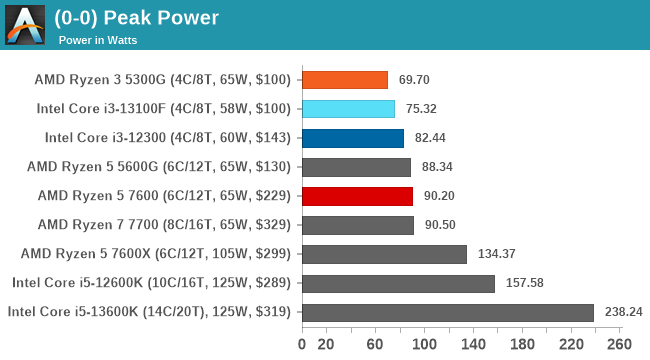
Looking at the peak power values for all of the sub $350 CPUs we've tested with the latest CPU suite, the Core i3-13100F, as expected draws the least power overall. The difference between the Core i3-13100F and the Core i3-12300 is around 7 W, which isn't massive, especially given they have the same Intel Golden Cove performance cores.
Diving into the power consumption of the Core i3-13100F during a Prime95 sustained load, we found that power was delivered consistently between 72 and 75 W, with no drop in frequency and power unless the compute load itself dropped off. This means that peak power is delivered for the duration when at full load. It also shows that Intel's Core i3-13100F is performing well within the associated turbo TDP power limit of 89 W.
Office/Web
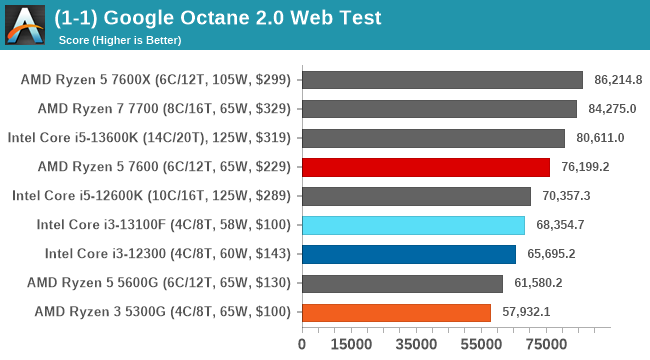
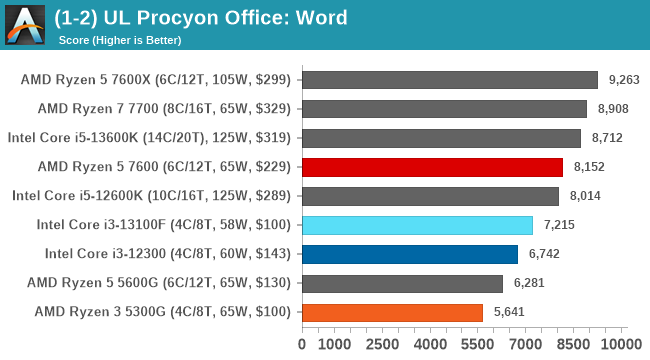
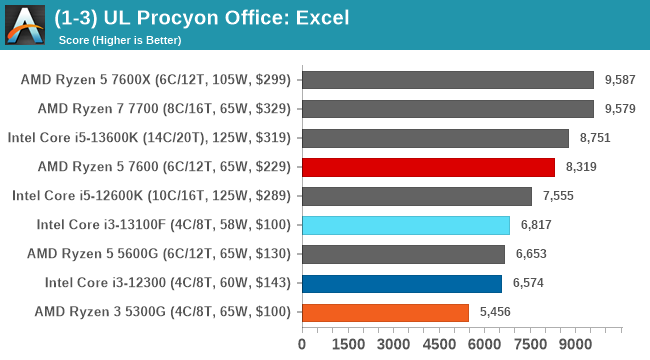

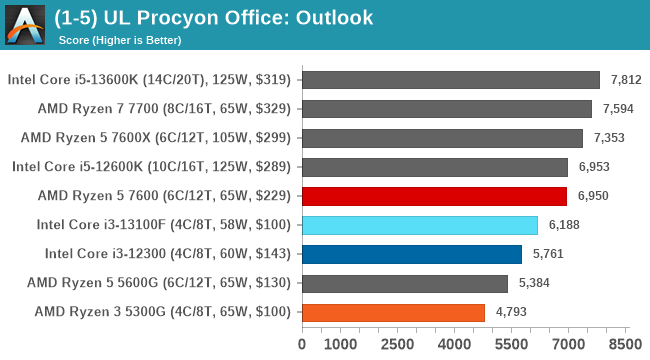
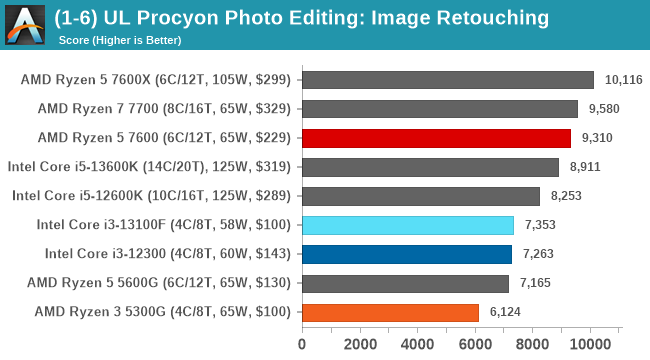
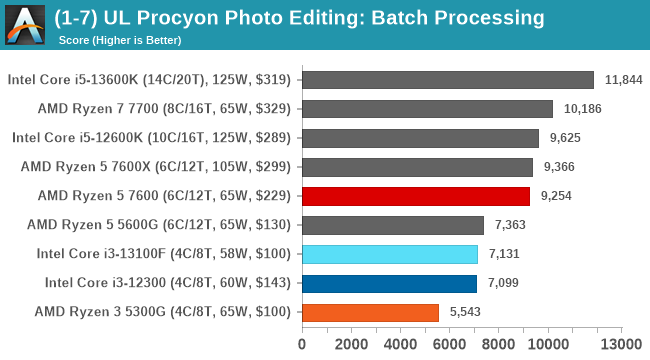

In office and productivity based benchmarks, the Core i3-13100F does very well considering it's a quad-core chip pitted up against six, eight, and even the Core i5-13600K, which is a 14C/20T part. As expected, the Core i3-13100F is slightly better than the Core i3-12300 as it has slightly faster cores.
Comparing Intel's latest quad-core to AMD's most recent quad-core, Intel has a distinct advantage in IPC performance as it's a newer process (Raptor/Alder Lake versus Zen 3) and clock speeds.











34 Comments
View All Comments
crimson117 - Monday, April 24, 2023 - link
I think if you're stressing the low-budget use case for these CPUs, you should test using their bundled CPU heatsink/fan just like most budget builders would do.It'd be nice to know if builders must budget for an additional $25+ cooler if the included one isn't up to the task.
GreenReaper - Monday, April 24, 2023 - link
Agreed, e.g. Wraith Stealth can technically dissipate 88W from a 7600 but it's a challenge - I got better (~101W) from a Noctua NH-L9a with the fan duct add-on, and up to 110W with another 92x25mm fan blowing into the duct. Intel has a larger area to dissipate from, so would be interesting to compare.Steelshots - Tuesday, May 2, 2023 - link
Ready to save time and money when it comes to buying steel shots? Look no further than Shot Blaster! Our bulk steel shots offer unbeatable prices and quick, efficient ordering. Enjoy the convenience and savings of buying in bulk today - and start reaping the rewards. Don't wait any longer - buy steel shots in bulk from Shot Blaster and start saving time and money today!x387 - Saturday, June 10, 2023 - link
In the first table, the Base W number for the i3-13100T should be 35W instead of 58W.